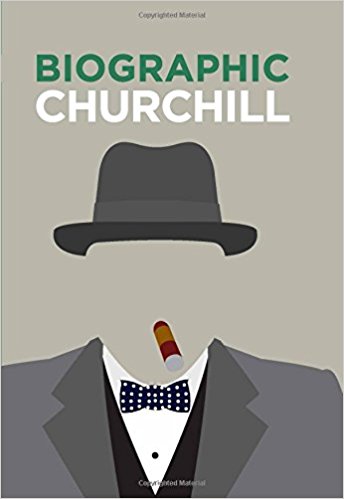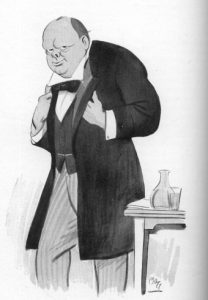
Finest Hour 179
Books, Arts & Curiosities – Graphically Efficient

April 22, 2018
Finest Hour 179, Winter 2018
Page 47
Richard Wiles, Biographic Churchill, Ammonite Press, 2017, 96 pages, £10/$14. ISBN 978–1791453018
Review by W. Mark Hamilton
W. Mark Hamilton is author of The Nation and the Navy: Methods and Organization of British Navalist Propaganda, 1889–1914 (Garland, 1986).
Biographic Churchill is one in a new series of small and short books that presents a unique way of looking at the world’s greatest thinkers. Each compact volume takes fifty defining facts, dates, thoughts, habits, and achievements and conveys this information to the reader using “infographics.” Author Richard Wiles examines Churchill’s life, world, work, and legacy. With an intentionally sparse text, the reader examining Churchill’s long and accomplished life is drawn to the custom-designed images on every page.
The book includes many lesser-known facts about Churchill, such as how many times he was shot at in his youthful military campaigns (more than fifty), his numerous health issues over a long lifetime, and a detailed account of his “very generous” drinking habits and profligate smoking (up to ten cigars a day). Churchill’s quotes and phrases fill the book, and the author estimates that Churchill wrote more than 16,000 pages and ten million words over sixty-four years, including a 345-page novel.

2025 International Churchill Conference
 Richard Wiles touches on Churchill’s painting as a pastime, his brick-laying efforts at his country home, his occasional mental health and stress-related challenges, and his famous—albeit sometimes questionable—wardrobe selections. Churchill’s fondness for gambling at French casinos is not excluded, nor are his estimated annual losses (£40,000). An extremely quick read, the book’s appeal is its visual images and abundant trove of statistics, which together provide an almost comic-book feel. This is not a book for the serious reader of history, but it is fun icing on the Churchill biographic cake. The vast use of statistics is hard to verify, and the statement that the “US/UK special relationship” existed in the nineteenth century is in error. There is no bibliography for further reading, and the index is minimal. The book’s real value is in giving readers a quick overview of Churchill’s life using brief sentences and statistics.
Richard Wiles touches on Churchill’s painting as a pastime, his brick-laying efforts at his country home, his occasional mental health and stress-related challenges, and his famous—albeit sometimes questionable—wardrobe selections. Churchill’s fondness for gambling at French casinos is not excluded, nor are his estimated annual losses (£40,000). An extremely quick read, the book’s appeal is its visual images and abundant trove of statistics, which together provide an almost comic-book feel. This is not a book for the serious reader of history, but it is fun icing on the Churchill biographic cake. The vast use of statistics is hard to verify, and the statement that the “US/UK special relationship” existed in the nineteenth century is in error. There is no bibliography for further reading, and the index is minimal. The book’s real value is in giving readers a quick overview of Churchill’s life using brief sentences and statistics.
To my eyes, regrettably no longer young, the book’s graphics are somewhat distracting, at times rather ugly, and rendered in a bizarre color scheme. But this eye-catching format may be ideal for younger readers and perfect for high school students in a social studies course: another advantage is that in an age of expensive book publishing, Biographic Churchill is available at a very affordable cost.
Subscribe
WANT MORE?
Get the Churchill Bulletin delivered to your inbox once a month.
Oops! We could not locate your form.
Privacy



